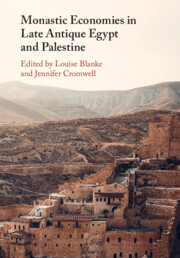Book contents
- Monastic Economies in Late Antique Egypt and Palestine
- Monastic Economies in Late Antique Egypt and Palestine
- Copyright page
- Contents
- Figures
- Tables
- Contributors
- Preface
- 1 The Monastic Economies in Late Antique Egypt and Palestine: Past, Present, and Future
- I. The Monastic Estate
- II. Production and Consumption of Food and Material Goods
- III. Monastic Encounters: Travel, Pilgrimage, and Donations
- 10 Distinguishing Offerings from Blessings in Early Byzantine Monasticism: The Significance of P.Ness. III 79 (ca. 600 AD)
- 11 Staple for Body and Soul: Working at and Visiting the Upper Egyptian Monastery Deir Anba Hadra
- 12 The Monastic Landscape of Mount Nebo: An Economic Pattern in the Province of Arabia
- 13 Travel in the Texts: Monastic Journeys in Late Antique Egypt
- Glossary
- Index
- References
10 - Distinguishing Offerings from Blessings in Early Byzantine Monasticism: The Significance of P.Ness. III 79 (ca. 600 AD)
from III. - Monastic Encounters: Travel, Pilgrimage, and Donations
Published online by Cambridge University Press: 14 April 2023
- Monastic Economies in Late Antique Egypt and Palestine
- Monastic Economies in Late Antique Egypt and Palestine
- Copyright page
- Contents
- Figures
- Tables
- Contributors
- Preface
- 1 The Monastic Economies in Late Antique Egypt and Palestine: Past, Present, and Future
- I. The Monastic Estate
- II. Production and Consumption of Food and Material Goods
- III. Monastic Encounters: Travel, Pilgrimage, and Donations
- 10 Distinguishing Offerings from Blessings in Early Byzantine Monasticism: The Significance of P.Ness. III 79 (ca. 600 AD)
- 11 Staple for Body and Soul: Working at and Visiting the Upper Egyptian Monastery Deir Anba Hadra
- 12 The Monastic Landscape of Mount Nebo: An Economic Pattern in the Province of Arabia
- 13 Travel in the Texts: Monastic Journeys in Late Antique Egypt
- Glossary
- Index
- References
Summary
The early seventh-century papyrus from the St Sergius Monastery at Nessana in Roman Third Palestine (Negev desert, Israel) illustrates how early byzantine monastic stewards categorized and handled lay donations. Called an ‘Account of Church Offerings’, P.Ness. III 79 preserves registers that formally separate gifts called ‘blessings’ (eulogiai) from ‘offerings’ (prosphorai). Though unique in the papyrus record, such categorical distinctions are also implied by contemporary hagiography; P.Ness III 79 confirms that monks formally recognized a categorical difference between these two types of gifts, as implied by hagiography. Moreover, hagiography indicates that blessings were considered gifts that did not oblige their recipients to give anything in return, while offerings expected recipients to provide some sort of service. Marks placed next to entries of offerings in P.Ness III 79 suggest that concern for obligation guided monastic stewardship practices. Such monastic practices and concerns may be illuminated by distinctions drawn between restricted and unrestricted gifts by modern non-profits.
- Type
- Chapter
- Information
- Monastic Economies in Late Antique Egypt and Palestine , pp. 271 - 297Publisher: Cambridge University PressPrint publication year: 2023

